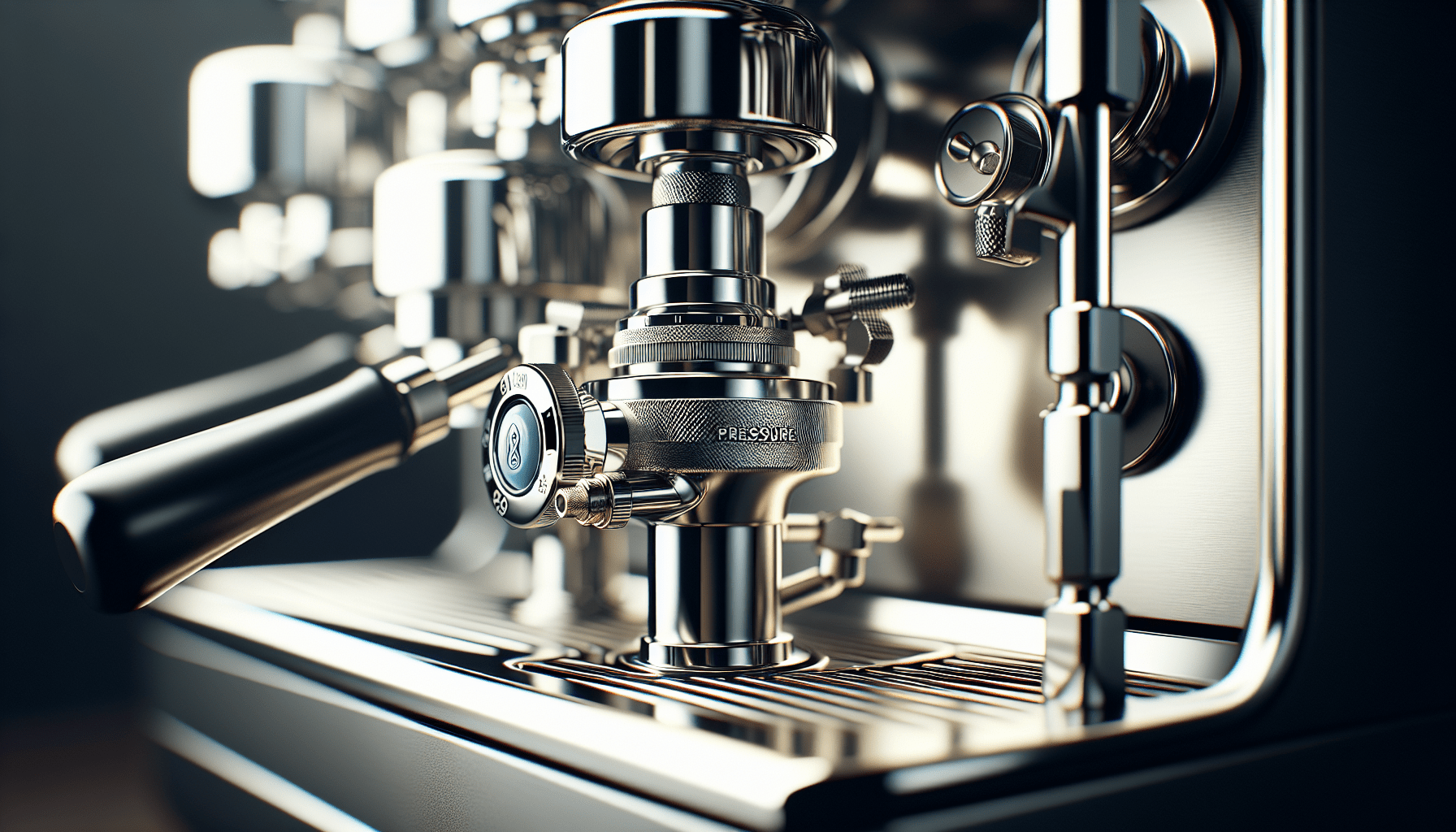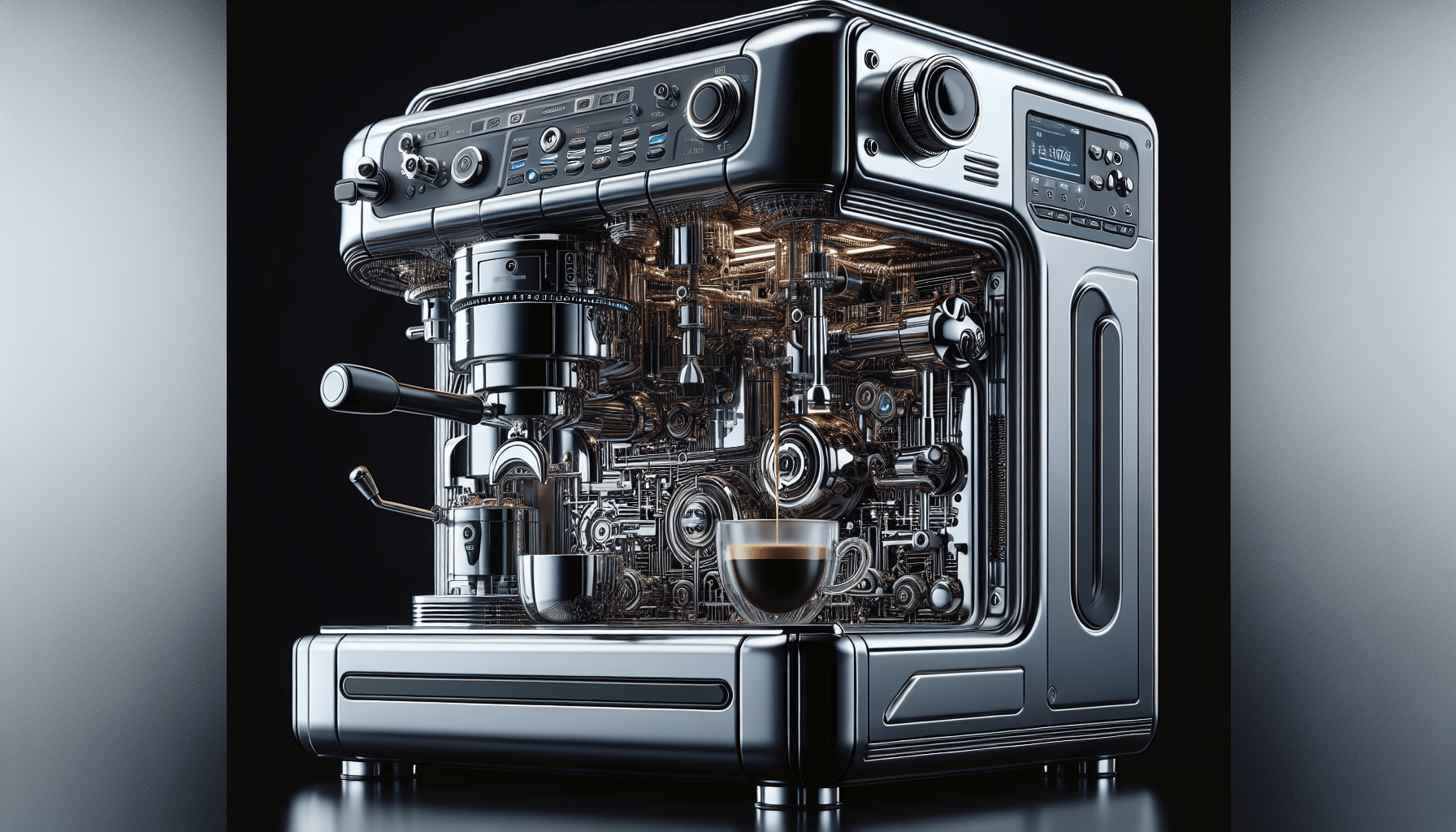So, you’ve just gotten your hands on a shiny new super-automatic espresso machine, but you’re not quite sure where to begin? Don’t worry, we’ve got you covered! In this article, we’ll take you through the step-by-step process of operating a super-automatic espresso machine, making that perfect cup of coffee a breeze. From grinding the beans to frothing the milk, you’ll be an espresso master in no time. Get ready to impress yourself and your friends with your newfound barista skills!
Understanding the Basics of a Super-automatic Espresso Machine
What is a Super-automatic Espresso Machine?
A super-automatic espresso machine is a high-tech appliance that is designed to simplify the process of making espresso. Unlike manual or semi-automatic machines, super-automatic machines handle everything from grinding the beans to brewing the espresso. With just a push of a button, you can have a freshly brewed cup of espresso in a matter of seconds. These machines are perfect for those who want convenience and speed without compromising on the quality of their espresso.
How Does a Super-automatic Espresso Machine Work?
Super-automatic espresso machines are equipped with advanced technology that automates the entire process of making espresso. They have built-in grinders, water tanks, and milk frothers, all of which work together to produce a perfect cup of espresso. When you press the button, the machine starts by grinding the beans to the desired fineness. It then tamps the ground coffee, forces hot water through the coffee grounds at high pressure, and finally dispenses the brewed espresso into your cup. All of these steps are done automatically, ensuring consistent results every time.
Key Components of a Super-automatic Espresso Machine
To better understand how a super-automatic espresso machine works, it’s important to familiarize yourself with its key components. These include the grinder, brew group, water tank, milk frother or steam wand, and various buttons and controls. The grinder is responsible for grinding the coffee beans to the desired fineness, while the brew group is where the coffee grounds are compacted and water is forced through them to extract the espresso. The water tank holds the water that is used for brewing and steaming, and the milk frother or steam wand is used to steam and froth milk for milk-based beverages. The buttons and controls allow you to adjust settings such as coffee strength and volume.
Preparing the Machine for Use
Check for Proper Power Supply
Before using the super-automatic espresso machine, it is important to ensure that it is properly connected to a power supply. Check that the power cord is securely plugged into an electrical outlet and that the machine is receiving power. This will prevent any issues during the brewing process and ensure that the machine functions properly.
Fill the Water Tank
One of the most crucial steps in preparing a super-automatic espresso machine is filling the water tank. It is important to use clean, filtered water to ensure the best taste and longevity of the machine. Open the water tank lid and fill it with water, making sure not to overfill. Some machines have a maximum fill line, so be sure to check for that. Replace the lid securely to prevent any leakage during the brewing process.
Ensure a Sufficient Bean Hopper
The bean hopper holds the coffee beans that will be used for brewing espresso. Before using the machine, make sure that the bean hopper is filled with enough beans. This will ensure that you have a sufficient supply of beans for multiple cups of espresso. Some machines have a capacity indicator, so be sure to check the level and add more beans if necessary.
Connect the Machine to a Water Source (if applicable)
If your super-automatic espresso machine has the capability to be connected to a water source, such as a direct water line, it is recommended to do so. This eliminates the need to manually fill the water tank and ensures a constant supply of water for brewing and steaming. Follow the manufacturer’s instructions for connecting the machine to a water source, as the process may vary depending on the model.
Adjusting the Coffee Strength and Volume
Understanding Coffee Strength
Coffee strength refers to the intensity of the coffee flavor in a cup of espresso. It is determined by the amount of coffee used in the brewing process and the extraction time. The strength can vary from mild to strong, depending on personal preference. Generally, a stronger coffee will have a higher concentration of dissolved solids and a more pronounced flavor.
Setting the Desired Coffee Strength
Most super-automatic espresso machines allow you to adjust the coffee strength to suit your taste. This can be done by selecting the appropriate setting or using the control panel. Experiment with different settings to find the ideal strength for your espresso. It is worth noting that a finer grind size and longer extraction time usually result in a stronger coffee, while a coarser grind size and shorter extraction time result in a milder coffee.
Choosing the Cup Size
Super-automatic espresso machines offer various cup size options, allowing you to customize the volume of espresso you want to brew. Consider the size of your cup or mug and select the appropriate setting. Some machines also have programmable options, allowing you to save your preferred cup size for future use. This ensures consistency in the amount of coffee brewed.
Selecting the Coffee Volume
In addition to choosing the cup size, you can also adjust the coffee volume to control the amount of espresso dispensed. This is particularly useful when making specialty drinks that require a specific coffee-to-milk ratio. Experiment with different volume settings to find the perfect balance for your taste preferences.
Grinding and Brewing Espresso
Selecting the Coffee Beans
When using a super-automatic espresso machine, it is important to choose high-quality coffee beans that are suitable for brewing espresso. Look for beans specifically labeled for espresso or beans with a dark roast profile. These beans are usually rich in flavor and have the ideal characteristics for brewing espresso. Avoid using pre-ground coffee, as freshly ground beans yield the best results in terms of taste and aroma.
Adjusting the Grinder Settings
Most super-automatic espresso machines have adjustable grinder settings, allowing you to customize the fineness of the grind. Experiment with different settings to find the ideal grind size for your taste. A finer grind is generally recommended for a stronger coffee, while a coarser grind works well for a milder coffee. Refer to the machine’s user manual for detailed instructions on adjusting the grinder settings.
Dosing and Tamping the Ground Coffee
Once the coffee beans are ground, the next step is to dose and tamp the coffee grounds into the brew group. The dosing process involves transferring the ground coffee from the grinder to the brew group. This is usually done automatically by the machine when the appropriate button is pressed. Tamping is the process of compacting the coffee grounds in the brew group to ensure an even extraction. Some machines have an automated tamping mechanism, while others require manual tamping using a tamper. Follow the machine’s instructions for dosing and tamping.
Starting the Brewing Process
With the coffee grounds in the brew group and the desired settings adjusted, you are now ready to start the brewing process. Press the appropriate button to initiate the brewing cycle. The machine will automatically deliver hot water through the coffee grounds at the specified pressure and temperature, extracting the espresso into your cup. The brewing time may vary depending on the machine and the desired coffee strength. Once the brewing process is complete, you can enjoy your freshly brewed cup of espresso.
Steaming Milk for Milk-based Beverages
Understanding Milk Steaming
Super-automatic espresso machines often come equipped with a milk frother or steam wand, allowing you to steam and froth milk for milk-based beverages such as cappuccinos and lattes. Milk steaming involves heating the milk to a specific temperature and creating a creamy and frothy texture. The quality of milk steaming can greatly influence the taste and presentation of your drinks.
Preparing the Milk Frother or Steam Wand
Before steaming milk, make sure that the milk frother or steam wand is clean and free of any milk residue. Follow the manufacturer’s instructions for cleaning and maintaining the milk frother. Position a container of cold milk under the steam wand, making sure the wand is immersed in the milk but not touching the bottom of the container. This will ensure proper steaming and frothing.
Steaming the Milk to the Desired Temperature and Texture
To steam the milk, turn on the steam function of the machine and position the steam wand just below the surface of the milk. Open the steam valve to release steam and create a swirling motion in the milk. As the milk heats up, gradually lower the container to maintain the desired consistency. The ideal temperature for steamed milk is around 150°F (65°C) for a latte and slightly hotter for a cappuccino. Once the desired temperature is reached, turn off the steam function and wipe the steam wand with a clean cloth. Give the milk container a gentle swirl to incorporate any foam created during the steaming process.
Cleaning and Maintenance
Regular Cleaning of External Surfaces
To keep your super-automatic espresso machine in optimal condition, it is important to regularly clean the external surfaces. Use a soft cloth or sponge dampened with water or a mild cleaning solution to gently wipe away any residue or stains. Avoid using abrasive cleaners or harsh chemicals, as these can damage the finish of the machine. Pay special attention to areas that come into contact with coffee grounds or milk, as they are more prone to buildup.
Cleaning and Descaling the Brew Group
The brew group is a key component of a super-automatic espresso machine and requires regular cleaning to prevent the buildup of coffee oils and residue. Refer to the machine’s user manual for instructions on how to remove and clean the brew group. Some machines have a self-cleaning function, while others require manual cleaning using water and a cleaning solution specifically designed for coffee machines. Descaling is also an important part of maintenance, as it removes mineral deposits that can affect the performance of the machine. Follow the manufacturer’s instructions for descaling the machine.
Cleaning the Milk Frother or Steam Wand
Proper cleaning of the milk frother or steam wand is essential to ensure the best quality milk for your beverages and prevent any clogs or blockages. After each use, wipe the steam wand with a clean cloth to remove any milk residue. If the wand becomes clogged, remove it from the machine and soak it in warm water to loosen any dried milk. Use a small brush or pipe cleaner to gently clean the internal parts of the wand.
Emptying the Drip Tray and Grounds Bin
The drip tray and grounds bin collect any excess water, coffee grounds, and waste from the brewing process. Regularly emptying and cleaning these components is important to maintain the cleanliness and functionality of the machine. Remove the drip tray and grounds bin, empty any contents, and rinse them with water. Use a mild cleaning solution if necessary to remove any stubborn stains or residue. Allow them to dry completely before reinserting them into the machine.
Troubleshooting Common Issues
Machine Not Turning On
If your super-automatic espresso machine is not turning on, check that it is properly connected to a power supply and that the power switch is in the “on” position. Ensure that the electrical outlet is functioning correctly by testing it with another device. If the machine still does not turn on, refer to the user manual or contact customer support for assistance.
Coffee Not Dispensing
If the machine is not dispensing coffee, check that the brew group is properly inserted and engaged. Ensure that the coffee beans or ground coffee are not blocking the grinder or brew group. If the problem persists, it may be due to a clogged or worn-out grinder or a malfunctioning brewing mechanism. Refer to the user manual or contact customer support for troubleshooting advice.
Weak Coffee Flavor
If the coffee flavor is weak or watery, check the coffee strength and volume settings to ensure they are properly adjusted. Also, verify that the coffee beans are fresh and properly ground. If the problem persists, it may be due to an issue with the brewing temperature or pressure. Consult the user manual or contact customer support for further assistance.
Milk Not Frothing Properly
If the milk is not frothing properly, ensure that the milk frother or steam wand is clean and free of any blockages. Check that the steam function is activated and that the steam wand is properly positioned in the milk. If the problem continues, it may be due to a faulty steam wand or a clogged milk frother. Refer to the user manual or contact customer support for guidance.
Unusual Noises or Error Messages
If you hear unusual noises or encounter error messages on your super-automatic espresso machine, it may indicate a technical issue. Consult the user manual or contact customer support for troubleshooting steps specific to your machine. It is important not to ignore any persistent issues, as they may worsen and affect the performance of the machine.
Additional Tips and Recommendations
Experimenting with Different Coffee Beans
Super-automatic espresso machines provide an excellent opportunity to explore different types of coffee beans and flavors. Consider trying beans from different regions or experimenting with blends and single-origin varieties. This can help you discover new and exciting flavors that suit your taste preferences.
Adjusting the Grinder Settings for Optimal Extraction
Fine-tuning the grinder settings can greatly impact the extraction and flavor of your espresso. If you find that the coffee is too weak or strong, consider adjusting the grind size slightly. Keep in mind that small adjustments can make a big difference, so take your time to find the perfect setting for your taste.
Using Freshly Roasted Coffee Beans
To achieve the best flavor and aroma in your espresso, it is recommended to use freshly roasted coffee beans. Ideally, use beans within two to three weeks of the roast date, as they are at their peak freshness and flavor. Look for local roasters or specialty coffee shops that offer freshly roasted beans for the best results.
Maintaining a Consistent Cleaning Schedule
Regular cleaning and maintenance are essential for the longevity and performance of your super-automatic espresso machine. Develop a cleaning routine and stick to it, ensuring that all components are cleaned and maintained according to the manufacturer’s instructions. This will help prevent any buildup or malfunctions and ensure that your machine continues to deliver delicious espresso for years to come.
Safety Precautions
Read the User Manual
Before using a super-automatic espresso machine, it is important to thoroughly read the user manual and familiarize yourself with all the features, functions, and safety guidelines. This will ensure that you operate the machine correctly and understand any potential risks or hazards.
Be Mindful of Hot Surfaces
During the brewing and steaming processes, various components of the machine can become hot. Take caution when handling these parts to avoid burns or injuries. Use oven mitts or designated handles to safely operate the machine and avoid touching hot surfaces.
Avoid Contact with Water and Electricity
As a safety precaution, be mindful of the electrical components of the machine and avoid exposing them to water or liquids. To prevent any electric shocks or damage to the machine, never immerse it in water or allow water to come into contact with any electrical parts.
Disconnect from Power Supply when Not in Use
When you have finished using the super-automatic espresso machine, it is important to disconnect it from the power supply. This minimizes the risk of accidents and prevents any unnecessary power consumption. Always unplug the machine when not in use or when performing any maintenance or cleaning tasks.
Conclusion
Operating a super-automatic espresso machine is an easy and convenient way to enjoy delicious espresso and other specialty coffee beverages. By familiarizing yourself with the basics of the machine and following the necessary steps, you can create barista-quality drinks in the comfort of your own home. Remember to adjust the coffee strength and volume to your preference, choose high-quality coffee beans, and maintain a regular cleaning schedule for optimal performance. With practice and experimentation, you’ll soon become a master of your super-automatic espresso machine, delighting in the rich flavors and aromas of freshly brewed espresso.




